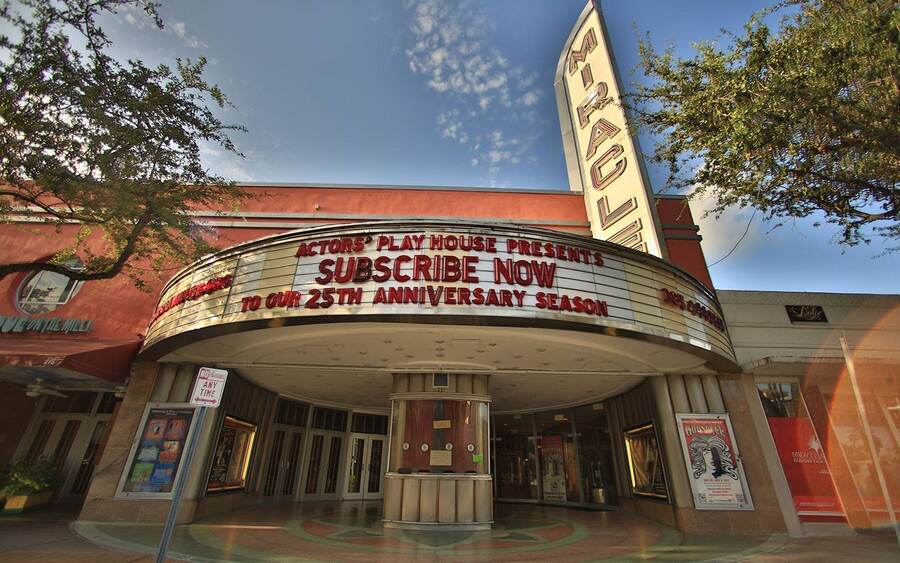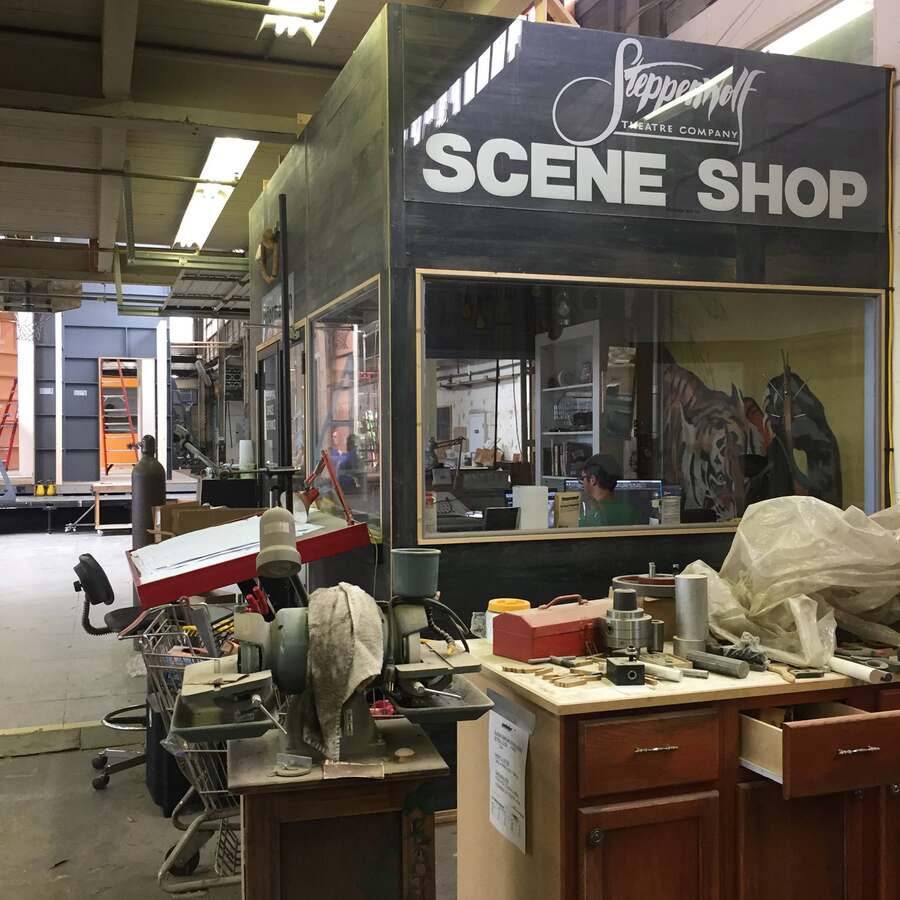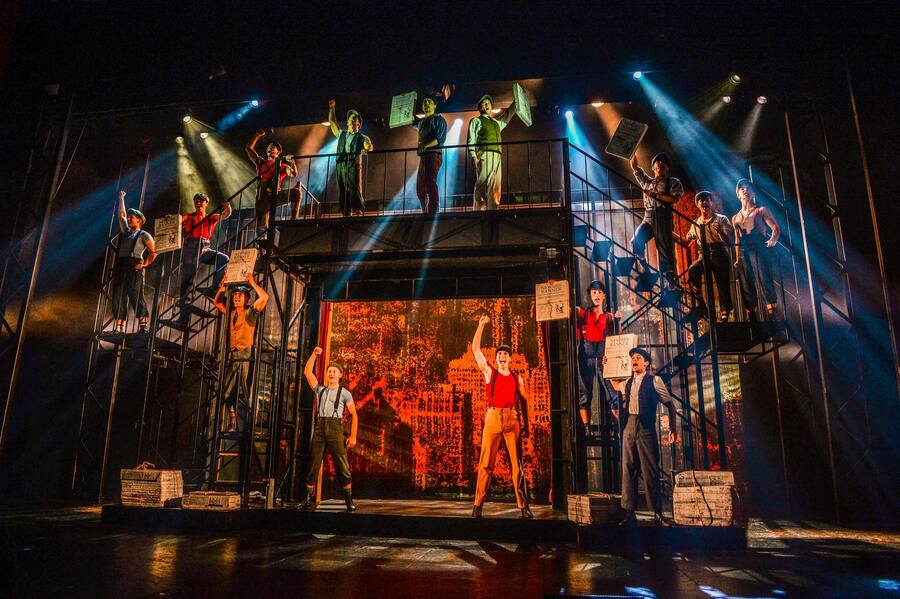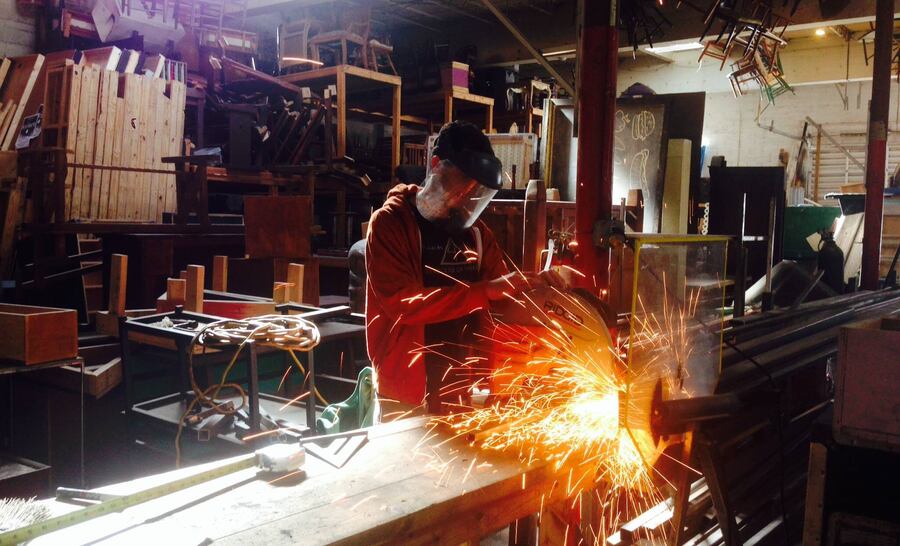As theatres have reemerged from pandemic closure in the past season, and audiences are returning, though in still lower numbers than before, there’s plenty of drama onstage. But behind the scenes there’s another drama that’s been unfolding: a quiet strangulation that only theatre insiders know about, which has affected everything from the expense of building sets to rehearsal scheduling, and perhaps most significantly what titles are being chosen for the 2023-24 season.
Put simply, it has become extremely difficult for theatres to find enough competent craftspeople, even to recruit untrained laborers who can hammer sets, paint flats, or sew costumes for professional regional theatres—least of all folks experienced in the sub-specialty of theatre work. Similarly, it has become much harder to find designers who are not overloaded.
“It’s every theatre that I talk to throughout the country and through TCG,” said William Hayes, producing artistic director at Palm Beach Dramaworks in Florida. “There are Zoom sessions with management throughout the country, and theatres are terrified. Because you can have all the money in the world, but when nobody’s left in the industry, that is not going to help you.”
This labor crunch has become a protracted crisis, said Patrick Fitzwater, artistic director and co-founder of the acclaimed Slow Burn Theater Company in Fort Lauderdale, Fla. His company, noted for its extensive sets and costumes for musicals, opened its own scene shop about a year ago, realizing its long-held dream of completely producing its own scenery of its own designs. But now, Fitzwater said, “I can’t staff it. It’s just sitting there. It has a brand new CNC (computer-controlled cutting) machine in there that nobody can operate. It’s a two-year lease, and we’re not using it at all. It’s a glorified storage space. It came down to the fact you could have all tools, but you had to have the labor and skills.”
As an example, he said the entire set of Slow Burn’s Little Shop of Horrors last October “was supposed to turn around, but there were no scenic people to really oversee that. So you ended up with a 5,000-pound house onstage that couldn’t function.” And the theatre’s two-level set for Footloose, built by whatever workers they could find to do it, seemed so unsteady that its second tier was scrapped during 11th-hour rehearsals and the show reblocked the night before opening last December.
Reluctantly, Slow Burn sent its design for the upcoming Newsies to a New York firm to build—swallowing a huge increase in cost, let alone the risk that it may not be shipped on time.
The burden may sound prosaic to civilians, but not for those on the other side of the footlights. From Seattle to Chicago, Milwaukee to Philadelphia, Miami-Dade County to Palm Beach County, artistic directors, designers, and artisans in professional regional theatres I interviewed all seemed to reading from the same script.
At Chicago’s Steppenwolf Theatre Company, director of production Tom Pearl detailed the challenge: “Jobs that used to take us three phone calls or emails to fill, now we will find we offer a position to 12 people before we find one person to take it.”
Alongside the staffing problem, the creation of sets and costumes is affected by other economic pressures: a sharp increase in the cost of materials due to inflation, compounded by the unreliability of the supply chain, and the drop in income from subscriptions.
These pressures can’t help but affect what audiences see onstage. “There are clear marching orders from theatres for simpler, less complex, and less staff-demanding designs,” said Jordon Armstrong, managing director for MNM Theatre Company in Palm Beach County, who also runs the company’s scene shop. “There’s a lot more lean into abstraction and theatrical convention as opposed to kitchen realism.”
At the 35-year-old tentpole Actors’ Playhouse in Coral Gables, artistic director David Arisco said, “We can’t do what we used to do. Those discussions happen every day. The sets have to be more minimalistic. The sets have to be more suggestive. The sets need to be less glorious.”

In the winter of 2020, many regional theatres employed a technical director and had a handful of full-time crew members for sets and costumes. But they also crucially relied on a variable number of experienced gig workers without benefits who might put in four to six weeks, then be left to their own devices for a month or two, then back for another three to six weeks.
When COVID slammed the production door that spring, not only were those gig workers let go, but so were most of the tech workers, including supervisors and managers.
The unexpected slamming on the brakes was traumatic for veterans like Jodi Dellaventura, best known as the go-to prop mistress in South Florida, who also could be found hammering flats, painting canvas, and designing scenery.
“Even though you have a solid job, it was taken away and you have no control,” Dellaventura said. “There was nothing like it. I didn’t work for two years.”
Some companies made an effort to retain staff. Milwaukee Rep laid off 10 to 20 percent of its staff, in contrast to many theatres, who instantly fired 60 to 90 percent. The Rep sought grants from philanthropists to keep their pay reliable.
“We repurposed their skill set,” said the Rep’s executive director, Chad Bauman. “They were building PPE for our hospitals. We knew that if we didn’t keep them employed, they would not only leave our theatre, they would leave the field, and then when we tried to reopen, we wouldn’t be able to reopen.”
Elsewhere, though, the exodus was devastating: carpenters, painters, welders, electricians, designers, seamstresses, technical directors.
“They weren’t going to sit around and be like, ‘Well, theatre will come back one day,’” said Matt Stabile, producing artistic director of Theatre Lab, the resident professional company at Florida Atlantic University, which specializes in new work. “They started to go and find that the skills that they were using in theatre could easily be applied to other areas.”
Indeed, those skills were highly marketable in a dozen areas: television, theme parks, corporate events, events, cruise ships, Vegas shows, even multi-million-dollar weddings. Carpenters just could build cabinets. For the most skilled, companies serving those other customers snatched up the artisans with higher pay and benefits.
“People who are either welders or carpenters, they’re working in shops now, making 30, 50, whatever, dollars an hour working and building stuff,” Dellaventura said.
As Actors’ Playhouse’s Arisco put it, crafts people “realized, Why am I working six jobs to work in the theatre and make this much money when I could just do this” one full-time job? “It’s not like they don’t have a passion for wanting to work in the arts—they do, they love what they do. But they also have bigger issues with paying their bills or juggling many jobs instead of having one that finally came through with benefits or finally came through with a decent pay rate.”
Stabile went further: “Frankly, it’s not shocking that some of those people would choose to not return to an industry that was kind of, ‘The show must go on and the play is the thing’—all these phrases we like to make ourselves feel better. But ultimately, it’s people putting that product together, and it can become exhausting to be like, ‘I’m going to put in 60 hours just to get the show up and running.’”
Many went back to school to finish degrees or add a new one. Many retrained in other professions. Some learned advanced computer skills. As the months of COVID turned into years, Bauman said, “Even in the performing arts, opera opened before we did…Theatres were the last to reopen. The longer we remain closed, the more instability began to creep in in terms of employment.”
When COVID figures began to dip, producers and artistic directors began trying out limited productions and planning a return to full seasons.
The problem: The workers were gone.

Even in a theatre town like Chicago, where some smaller companies have folded or remain in limbo, the number of people willing to work in theatre has shrunk, said Steppenwolf’s Pearl.
When scenic designer Sean McClelland designed Cinderella at the Wick Theatre in Boca Raton, he said the dearth of scenic painters led the company to reach out to 30 scenic painters in New York City—with no luck. Finally, Kimberly Wick, the theatre’s associate producer, found a painter who could “drive over at 9 o’clock at night from the west coast of Florida. She stayed in a hotel. She painted for three days. Then she went back. Then she came the following weekend, painted for three days, and then she went back, and I finished it.” Indeed, Wick said, she herself painted “half of the set for Cinderella.” After doing the same for their production of Damn Yankees, though, she said, “I took my paint clothes and threw them in a ball and threw them out. I said, ‘I am not painting another set. I am 60 years old, and I can’t do it anymore.’ ”
Similarly, at Slow Burn, Fitzwater and his managing director, Matthew Korinko, found themselves with paint brushes in hand.
“It’s like all the theatres are pulling out the same three (scenic artists) that are still available,” said McClelland, owner of Symbiont Scenic in Santa Fe, N.M.
The number of people actually designing and building sets and costumes seems to have dwindled everywhere. Actors’ Playhouse, for instance, once had six to seven regularly employed staff in the scenic shop; now it’s three or four. The costume shop’s staff of four is down to one.
Indeed, with supervisory technical directors having to step in to do everything from design to engineering to hammering nails, their disappearance is no surprise to McClelland. “The TDs are so burned out,” he said. “Who wants to work for $40,000 a year, be in charge of building all the shows, the building’s maintenance, everything on top of it? Now theatres can’t even fill the top position, which is ridiculous.”
McClelland is still doing some of the corporate work that got him through the pandemic, but this past season he had six assignments from theatres, and he has others on the table. He’s glad for the work, but the glut of demand reminds him that many of his designing colleagues have simply left the business because they were burned out.
For his part, Rick Pena, a founding member of Slow Burn Theater and its long-time costume chief, spent the pandemic designing costumes at a wealthy private school in Broward County with an active theatre department. The only reason he returned to Slow Burn, he said, is that they offered him a salary position with benefits, “which is unheard of. I can probably count, not even on my hand, how many costume designers have that in South Florida.”

The short-term workarounds for this ongoing crisis have been simple but deeply problematic: renting sets and costumes, or hiring an outside company to do the work at an even higher cost, or hiring inexperienced hands. The lack of experience among the most eager newbies can be a big issue in the specialized art of theatrical scenery and costumes.
MNM Theatre Company’s scene shop, meanwhile, has stayed open by designing and/or building and/or installing sets for about 20 productions total in the past season, often for other companies in the region, with just two full-time carpenters.
“The one downside of theatre carpentry is, you can’t just get a contractor come in and build stuff,” MNM’s Armstrong said. “I mean, they could do it, but it’s going to be overly expensive and overly heavy, because they’re used to building houses and walls and support structures as opposed to facades. We make a bunch of boxes and tell the audience they’re not boxes. It’s all smoke and mirrors. There’s architecture in it, but it’s architecture built out of Popsicle sticks and sheer will.”
The fallback cited over and over is hiring outside companies. But the cost of farming it out is considerable, said Morgan Green, lead artistic director for the Wilma Theater in Philadelphia. “It’s one of the most expensive things—easily five times more expensive than any other component of the production,” she said.
A few years ago, an outside company might charge $8,000 to produce a set; now it can be as much as $35,000 to $45,000, McClelland said.
Of course, theatres are striving to keep loyal audiences from noticing any significant change in quality, or even scope. Some companies felt that audience’s past expectations for impressive sets and costuming forced them to dig even deeper when they initially reopened, as if to say, a la Sondheim, “We’re still here.”
Milwaukee Rep, for instance, reopened last fall with a 33-actor version of Titanic, buoyed by the fact that they had kept much of their staff intact. “Our thought process was, we wanted to give somebody a reason to get off their couch and away from Netflix,” Bauman said.
Exacerbating these challenges is the rising costs in materials these days—when you can get them.
“We are seeing sometimes a 30 to 50 percent increase in the price of materials,” said John Langs, artistic director at ACT in Seattle.
Steel, hammers, screwdrivers, even the casters to roll on scenery have doubled in cost. While the inflationary spikes have subsided a bit in recent months, bills for the crucial element of lumber tripled earlier in the comeback, Stabile said.
Price tags have also doubled for items most non-theatre folks wouldn’t even think about, like 3M adhesive spray and spray paint, Wick said. Agonizing decisions have to be made on spreadsheets. As Armstrong put it, “It’s always the fine line of, is it going to cost more with a man-hour labor to fix it up, or is it worth getting new?”
So even if you can find the workers you need, you may not have the materials in hand for them to work with.
“That goes to everything,” said Steppenwolf’s Pearl. “In the beginning, it was plywood, manufactured goods. The scene shop now has to keep hardware on hand. Say our costume shop needs a red slip. We used to go to two or three shops; now we have to go to seven or eight. We have had to pivot in our expectations, because Amazon and overnight delivery is not always reliable.”
Planning ahead is no assurance. Said ACT’s Langs, “Even when we think we’re months ahead, we just sit there biting our nails, going, ‘Is it going to get here on time so that we have time to do the excellent work that we know how to do?’ ”

Companies have been experimenting with and weighing a dozen solutions, some temporary, some permanent. Some, like Palm Beach Dramaworks, are choosing one or two titles with elaborate sets for their 2023-24 season, interspersed with shows that require only minimal scenery.
And some theatres are looking to integrate design parameters within their season. At the Wilma, designer Matt Saunders, Green said, “chose some standard sizes for the platforms and for the walls, so that we didn’t have to have them custom built” for each show. “We could use existing flats and platforms and just paint them a different color.”
Similarly, Langs said, ACT and “other theatres are treating designs like we would if we were running repertory theatres, employing a single designer to do a repertory plot for the season to save on the labor that it takes to do a full strike and rehang and focus. We’re looking at saying, ‘Here’s the whole pie of the year, and here are the seven stories that we’re going to tell within this that have to be told with these resources.’”
While most theatres once indiscriminately consigned nearly everything to the garbage pickup alley after strike, no more. The set for MNM Theatre’s The 25th Annual Putnam County Spelling Bee “was entirely stock pieces that we repurposed, repainted, cleaned up. It’s cheaper to clean up the dings and the staple holes on old pieces than it is to buy new materials,” Armstrong said.
Saving scenery, props, costumes, and the like poses a new problem: Most companies have limited or no storage space, and renting warehouse space is an added expense for the budget.
Other solutions require adjustments to the budget as well. Theatres that have staggered work hours over shorter days find that it takes more overall days. “We made the build weeks longer, which costs more money,” said Slow Burn’s Fitzwater. “That way we could bring people in who weren’t working their day jobs to come in from 6 to 10 at night to build rather than an eight-hour day.”
Importing workers when the local hiring pool is thin is one solution, but that requires housing and other amenities. Similarly, if a company is associated with a college drama department, students can be hired for pay or given an internship during the summer to begin work for the coming season. But the training and mentorship these student workers require is a further investment of labor on the part of already strained staff.
When preferred set and costume designers are overwhelmed, some theatres have resorted to borrowed designs and/or rented scenery. Even with its own sophisticated scene shop, the Maltz Jupiter Theatre rented the main drape for A Funny Thing Happened on the Way to the Forum from Geva Theatre in Rochester. For its Oliver!, it bought drawings from the production at the Muny in St. Louis.
Hayes, whose Dramaworks also has its own scene and costume shops, has floated a provocative blue-sky proposal that would take cooperation to a more formal business level: What if three or four similarly sized theatres shared a central production center? They could jointly pay competitive salaries for experienced hands as well as provide plenty of full-time work, especially if theatres began their design processes a full year in advance. (Though government-supported and now closed, a similar paradigm combined with production spaces called the Arts Incubator operated for years in an old school building in Arlington, Va.)
One possible option in the future for theatrical design—one that few folks welcome—is the use of architectural artificial intelligence programs like Midjourney, which have been used “on paper” to create initial visual set design images.
“There’s already college kids writing pieces on it and how they think it’s going to replace all set designers in 10 years,” McClelland said. “Some people have gotten pretty good at it. They’ll be like, ‘I want to do Wicked with an Andy Warhol sensibility,’ and it just instantly pops up images of what that set would look like. There’s already a lawsuit starting.”

Of course, the obvious solution to a labor crunch and rampant burnout is to improve labor conditions. Most theatres have nixed the traditional 10-out-of-12 tech “hell weeks,” for starters, and other theatres have instituted five-day work weeks.
“The theatre used to run on people’s goodwill, and people would work endless hours and late into the night and make it happen,” said the Wilma’s Green. “That is no longer acceptable. That is not a healthy work environment.” She said that the Wilma is “dedicated to this cultural shift where it’s a good place to work, you are compensated fairly for your labor, you are treated well, and you feel safe when you come to work, etc.” Of course, “That just means that it’s more expensive, and that means that there’s less money for other things. So we’re putting more resources toward the people rather than the work, but then the work suffers. So we have to find a balance.”
At Theatre Lab, Stabile said, “I hope that the outcome is that we’re starting to value people more. We’ve been doing a lot of work at our theatre about what systems we can put in place to make sure that we’re providing ample time to get projects finished, and that nobody has to pull an all-nighter.”
Some theatre workers took the opportunity of the pandemic pause to rethink their commitment. For her part, prop mistress Dellaventura she opened a candle business and began meditation. As theatres have reopened, she’s returned with a different attitude.
“I had been working until three, four in the morning,” she recalled. “I was working on literally, like, six shows at the same time. I don’t do that anymore…I don’t work past midnight anymore, and I don’t work on as many shows anymore. I do other things for myself now. I find that I’m much happier. I still love theatere and I love doing what I do and I still put forth my same energy. I’m just not doing as many things as I was now.”
Looking ahead, most of the folks interviewed exuded that unique theatrical meld of hope and practicality, but offered few concrete predictions. “Theatres are always a survivor,” McClelland said.
But what about theatre workers? Most theatre leaders have noticed a noticeable drop in the number of young people coming out of school who are willing to work onstage, backstage, or in the shops.
McClelland’s hope is “that the next batch of college kids coming through are going to realize that there is a higher demand in this field,” and that the pay is better than it was “five years ago, when you came out of college with a degree in tech or design and found a low-level internship somewhere. I hope they realize there is quite a demand, and the possibility of an actual career.”
Bill Hirschman is founder and chief critic for Florida Theater On Stage, a for-profit arts journalism website for 12 years. A theatre critic and arts journalist for 25 years, he is a former chairman of the American Theatre Critics Association.


